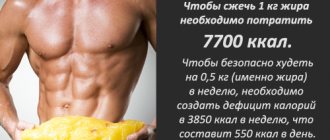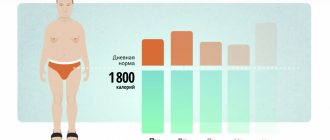When does a bodybuilder become a bodybuilder?
Bodybuilders are not born, they are made. Every experienced athlete and winner of numerous competitions was once a beginner and took his first steps, mastering the gym, and some started with home workouts. To reach the level of a professional, you need to study hard for 2.5-4 years. Such a large spread in time is due to the fact that all people are different. The final result is influenced by five factors:
- regularity of training;
- nutrition;
- Lifestyle;
- initial data;
- genetics.
Two different men who follow the same training plan, have similar parameters and eat the same food can have very different progress. Simply because one of them sleeps 8 hours a day, and the other sleeps 6. If a person initially came to the gym with a lot of excess weight, he will need more time, since he first needs to get rid of fat.
Thus, if we talk about professional sports, we should focus on a period of 2.5-4 years. However, the first results will be noticeable much earlier. Moreover, if you compare your own reflection in the mirror after the first and tenth training, you will notice a significant difference. Of course, this is only true if you take your studies seriously.
Program for pumping the muscles of the sternum
Training should be based on a scheme, that is, a training program. The plan is drawn up at the beginning of classes and adjusted based on your own feelings, progress, recovery speed and other factors.
The plan will be different for beginners and more experienced athletes. At first, it is recommended to perform fewer exercises, giving preference to basic, multi-joint movements. Then the isolated ones are included, and other diversity is introduced.
For newbies
When we pump our chest, other muscles come into play. This factor must be taken into account when creating a training program. For beginners, it is better to train according to the principle of a three-day split, focusing each workout on two or three muscles.
A sample plan looks like this:
| Workout 1 | Legs and shoulders. 2-3 leg exercises (for example, squats, lunges and machine leg presses), then 2 shoulder exercises (standing barbell press and seated dumbbell press) for 3-4 sets of 6-12 reps. |
| Workout 2 | Chest and triceps. Bench press 4 sets of 8-15 reps. Incline dumbbell press, 3 sets of 8-15 reps. Dumbbell flyes, 3 sets of 10-12 reps. Triceps on the block, 4 sets of 10-15 reps. Dips, 4 sets of 10-12 reps. |
| Workout 3 | Back and biceps. Option: deadlift, barbell row, pull-up, biceps curl, dumbbell curl on a Scott bench. 3-4 sets of 6-12 repetitions. |
Training can be alternated differently. For example, the pecs can be combined with the back, shoulders, and so on. The main thing is that the body has time to recover. Before pumping the lower chest separately (or the upper), it is worth paying attention to the overall development, then the weaknesses will become clear, and the program will change depending on them.
For advanced
More experienced athletes can pay more attention not to general training, but to individual parts of the pectoral, isolating movements. But before training the lower part of the sternum muscles or, conversely, the upper part, it is worth performing basic exercises, only then moving on to special movements.
A chest/triceps training day might look like this:
- bench press, 4 sets of 10-12 reps;
- dumbbell press, 3 sets of 10-15 reps;
- Incline bench press, 3 sets of 12-15 reps;
- crossover, 3 sets of 12-15 reps;
- French press, 4 sets of 12 reps;
- bent over triceps extension, 3 sets of 10-12 reps.
Another training option for combining the load on the chest and shoulders is as follows:
- bench press with a barbell, 4 x 10;
- Smith machine press, 3 x 10;
- crossover, 3 to 12;
- dumbbell flyes, 3 to 12;
- standing barbell press, 4 x 12;
- Arnold press, 4 to 12-15.
There are quite a lot of options. For example, a five-day split can be used, when training is carried out 5 times a week, then a separate day is devoted to the chest, approximately 5-6 movements are performed.
You may also be interested in: How many times a week should you exercise?
Gaining muscle mass: exact numbers
Sports medicine claims that a man with average parameters (height 178-180, weight 70-75 kg) can gain about 600-900 g of pure muscle mass in a month. This is a good indicator. Moreover, such results are possible only with intensive training and proper nutrition with a calorie surplus and a predominance of protein foods in the menu.
Gyms have their own statistics, according to which the most zealous beginners gain no more than 7 kg of mass per year. Moreover, this is only true for people who work out with a personal trainer, eat by the hour and adjust their training plan every week under the supervision of an experienced specialist. A man working out on his own, without understanding the specifics of how different muscle groups work, is unlikely to be able to achieve the same results.
From beginner to professional in 4 stages
The issue of training needs to be approached thoroughly, but first you need to understand the peculiarities of how the body works. The good news is that absolutely anyone can pump up, regardless of their initial parameters. The only difference is how much time it takes to get the desired result.
A person with an asthenic physique will have to become closely acquainted with sports supplements, and in some cases they cannot do without anabolic steroids, of course, if we are talking about professional sports. The advantage in this case is that you can start training to gain muscle mass almost immediately. But a man with a lot of excess weight is less fortunate - he will first have to lose kilos, then make efforts for several months to maintain what he has achieved, and only after his body gets used to it, move on to intensive training to gain weight. This is true for women too.
The path “from beginner to muscleman” will consist of four stages:
- preparation of the body;
- muscle hypertrophy;
- muscle hyperplasia;
- adaptation to maintain what has been achieved.
If we are talking about a person with significant excess weight, two more points are added to this list - weight loss and adaptation.
Adaptation after weight loss should be discussed in more detail. If you are overweight, the body begins to work differently, of course, if we are talking about significant fat deposits - 20 kg or more. To maintain vital functions with such an additional load, adaptive processes are launched, as a result of which the heart rate, blood pressure, respiratory rate and other indicators change. Losing weight is only possible with proper nutrition with a calorie deficit and intense training with an emphasis on basic multi-joint exercises. After eliminating excess weight, the body works according to the “old scheme” for 3-4 months, because adaptive mechanisms have already been established. Accordingly, in a person who has lost weight, all processes are “sharpened” to greater weight, to which the body has long been accustomed. To “reconfigure” it is necessary to continue living in the same regime aimed at losing weight for at least 90 days after achieving the goal. The main emphasis is on diet, calorie intake and regular training. The human body is quite lazy, so it’s easier for it to put off excess weight again than to “reconfigure”, so in the first three months after losing weight, it will strive to return to its previous shape, intensively storing fat. If during this period you switch to a diet designed to gain muscle mass, a person will get the opposite effect and simply gain extra pounds, despite training.
Preparing the body
The first stage that absolutely every beginning athlete goes through is preparation. It consists in increasing overall performance and getting the muscles used to the load. This period lasts about 100 days - this is exactly the period the body needs to make the muscles work effectively.
When starting classes, you need to focus on basic multi-joint exercises, including weights. The advantage of this approach is the rapid development of the body. It’s interesting that literally after the third workout a beginner will already see real results, and at the end of the second month a noticeable weight gain is possible - plus 2-3 kg.
The preparatory stage launches important mechanisms without which hypertrophy is impossible. This happens as follows.
The human body is quite lazy and does not like to experience stress. The first workout will be the hardest, because the body is subjected to enormous stress and spends a lot of energy. The central nervous system perceives this as the “beginning of the end”, as a result, mechanisms are launched that allow you to take on more weight with less energy consumption. During training, glycogen is actively released, but adaptive mechanisms are activated, and during moments of rest from exercise, the body tries to store this polysaccharide as much as possible. The result of these complex processes is the coordinated work of muscle fibers. As a result, over time, less energy is spent on the training process, and overall endurance and strength increase.
Don’t delude yourself that it will always be like this – this is just the first step towards the body of your dreams. After about 100 days, the preparation stage is completed, the body gets used to the changed loads. If at first there is fairly rapid progress, muscles grow, weight increases, then after three months these processes slow down. And in fact, this is a good sign: the efficiency and coherence of the fibers has increased, which means the possibility of hypertrophy has opened up.
Muscle hypertrophy
Hypertrophy is an increase in the volume and mass of skeletal muscles. It is through this process that it is possible to pump up voluminous biceps and increase shoulder width. Conditions necessary for effective hypertrophy:
- good general endurance and completed preparatory training phase;
- regular and balanced loads;
- properly composed diet;
- rest.
There are several hypotheses explaining the cause of skeletal muscle hypertrophy. This process is the body's response to increased stress. According to one theory, during strength exercises, muscle fibers rupture due to high tension and hypoxia. These processes trigger active protein synthesis, which is spent on strengthening the fibers. During this period, it is very important for the body to receive all the necessary macronutrients, so diet plays a vital role. To increase muscle mass, you need easily digestible protein, which can be obtained from foods or sports nutrition.
The second important nuance is the alternation of load and rest. Too much training won't do you any good. It is best to exercise every other day so that the body has time to recover.
The good news is that muscles gain maximum volume in 24 months. Thus, from the end of the preparatory stage to the receipt of the final form that a particular organism is capable of, no more than two years of regular training will pass. During preparation, it is possible to gain about 2-3 kg of muscle mass, in the first year of active hypertrophy - 15-17 kg, in the second year - no more than 10-12 kg. The data is given for a man of average height and without excess weight. It is assumed that the person got rid of excess weight, if any, before the hypertrophy stage began.
The bad news is that after two years, progress slows down. There are two options here - either accept it and train to stay in shape, or move on to the next stage.
Muscular hyperplasia
Hyperplasia is the growth of tissue; in bodybuilding, this term refers to the process of dividing muscle fibers. It should not be confused with hypertrophy - with it the fibers thicken, but their number does not change. With hyperplasia, the fibers become larger due to the division of existing ones.
An important fact: the number of muscle fibers a person has is determined by genetics. During life, their number does not change, but they can decrease or increase in volume. With hyperplasia, everything is also not so simple, although this topic is widely discussed in the circles of professional athletes. According to some data, this process does not have a significant effect on muscle size, as it increases the number of fibers by no more than 5%. Also, the possibility of dividing muscle fibers in humans during strength training to the limit of capabilities has not been proven.
Today, there are two options for stimulating hyperplasia - high-volume training with low weight or taking advances in sports pharmacology. High-volume training is a high-repetition exercise, all exercises are performed 15 times, the weight used is 60-70% of the maximum the athlete can train with. The key point is minimal rest between sets (no more than 60 seconds).
Many athletes resort to the pharmacological method of stimulating muscle hyperplasia, but it has many contraindications.
Adaptation stage
The last stage does not take much part in the formation of a strong and pumped up body, but is an important component of the training process of professional athletes. It consists of forcing the body to work to its limit, “pumping” the cardiovascular, lymphatic and nervous systems. This is achieved through functional training and intense aerobic exercise. The disadvantage of this method is that the body gets used to it over time. An example of this is professional squash players or tennis players, who during cardio training cannot raise their heart rate above 150 beats per minute, since the cardiovascular system is simply accustomed to such loads.
The adaptation stage has no deadline. Most often, bodybuilders resort to such exercises during preparation for competitions, which becomes part of the cutting program.
About recovery and training program
A properly designed training plan will help you achieve quick results. During the period of preparation and stimulation of hypertrophy, it is necessary to correctly combine basic and isolated exercises. For example, to pump up the pectoral muscles, you need presses. For enhanced hypertrophy, it is necessary to “injure” the muscle fibers, so presses are performed with heavy weights. And for increased growth in gluteal volume, you should focus on deadlifts and squats with weights. In general, anyone who wants to achieve results needs to master barbell work to build muscle.
When creating a training plan, you need to consider how much time different muscle groups require to recover. If you don't give them rest, there will be no progress and the athlete will quickly face burnout.
All large groups (lats and trapezius, pectorals, hips and buttocks) are restored within 72 hours. It takes about two days to restore the deltoids, triceps, biceps, and abs. Thus, you cannot train your back on Monday and Wednesday - the lats and trapezius simply will not have time to recover, which means there will be no result other than delayed onset muscle pain syndrome. But on Monday and Friday you can load this zone without fear. This is important to consider when working on a lagging group, as many people make the mistake of loading one area too often.
Having figured out how much time it will take to pump up muscles, you should decide on the goal. Results that satisfy most people can be obtained in just six months, and the first progress is noticeable within a month. The muscles will acquire maximum volume after 24 months of regular training, but whether it is necessary to go further is something everyone decides for themselves.
What exercises for home and gym should be included in the program for pumping up the pectoral muscles?
Pumping the chest muscles and working on mass is carried out through a series of exercises. The most popular basic movements when training in the gym are:
- bench press on a horizontal bench;
- incline bench press;
- dumbbell press on a horizontal and inclined bench;
- raising dumbbells on a horizontal and inclined bench;
- presses in simulators;
- dips;
- crossover.
This is the main backbone on which the training program is built.
Breast development at home is done using push-ups. They should be the main exercise. Such exercises are performed according to various schemes, different positions of the arms and legs are combined, and additional weight is used (for example, in a backpack).
You may also be interested in: Chest exercises at home










